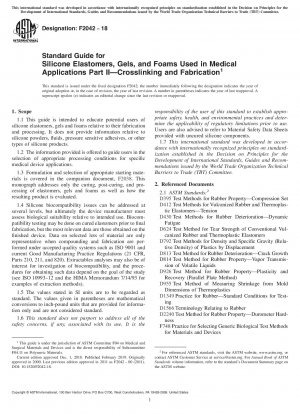ASTM F2042-18
Standard Guide for Silicone Elastomers, Gels, and Foams Used in Medical Applications Part II - Crosslinking and Fabrication
- Standard No.
- ASTM F2042-18
- Release Date
- 2018
- Published By
- American Society for Testing and Materials (ASTM)
- Latest
- ASTM F2042-18
- Scope
- 1.1 This guide is intended to educate potential users of silicone elastomers, gels and foams relative to their fabrication and processing. It does not provide information relative to silicone powders, fluids, pressure sensitive adhesives, or other types of silicone products. 1.2 The information provided is offered to guide users in the selection of appropriate processing conditions for specific medical device applications. 1.3 Formulation and selection of appropriate starting materials is covered in the companion document, F2038. This monograph addresses only the curing, post-curing, and processing of elastomers, gels and foams as well as how the resulting product is evaluated. 1.4 Silicone biocompatibility issues can be addressed at several levels, but ultimately the device manufacturer must assess biological suitability relative to intended use. Biocompatibility testing may be done on cured elastomers prior to final fabrication, but the most relevant data are those obtained on the finished device. Data on selected lots of material are only representative when compounding and fabrication are performed under accepted quality systems such as ISO 9001 and current Good Manufacturing Practice Regulations (21 CFR, Parts 210, 211, and 820). Extractables analyses may also be of interest for investigation of biocompatibility, and the procedures for obtaining such data depend on the goal of the study (see ISO 10993–12 and the HIMA Memorandum 7/14/93 for examples of extraction methods). 1.5 The values stated in SI units are to be regarded as standard. The values given in parentheses are mathematical conversions to inch-pound units that are provided for information only and are not considered standard. 1.6 This standard does not purport to address all of the safety concerns, if any, associated with its use. It is the responsibility of the user of this standard to establish appropriate safety, health, and environmental practices and determine the applicability of regulatory limitations prior to use. Users are also advised to refer to Material Safety Data Sheets provided with uncured silicone components. 1.7 This international standard was developed in accordance with internationally recognized principles on standardization established in the Decision on Principles for the Development of International Standards, Guides and Recommendations issued by the World Trade Organization Technical Barriers to Trade (TBT) Committee.
ASTM F2042-18 Referenced Document
- ANSI/AAMI ST50
- ANSI/AAMI ST79
- ASTM D1349 Standard Practice for Rubber-Standard Temperatures for Testing
- ASTM D1566 Standard Terminology Relating to Rubber
- ASTM D2240 Standard Test Method for Properties of Rubber &8212; Durometer Hardness
- ASTM D395 Standard Test Methods for Rubber Property-Compression Set
- ASTM D412 Standard Test Methods for Vulcanized Rubber and Thermoplastic Elastomers8212;Tension
- ASTM D430 Standard Test Methods for Rubber Deterioration-Dynamic Fatigue
- ASTM D624 Standard Test Method for Tear Strength of Conventional Vulcanized Rubber and Thermoplastic Elastomers
- ASTM D792 Standard Test Methods for Density and Specific Gravity (Relative Density) of Plastics by Displacement
- ASTM D813 Standard Test Method for Rubber Deterioration-Crack Growth
- ASTM D814 Standard Test Method for Rubber Property—Vapor Transmission of Volatile Liquids
- ASTM D926 Standard Test Method for Rubber Property-Plasticity and Recovery (Parallel Plate Method)
- ASTM D955 Standard Test Method of Measuring Shrinkage from Mold Dimensions of Thermoplastics
- ASTM F2038 Standard Guide for Silicone Elastomers, Gels and Foams Used in Medical Applications Part I - Formulations and Uncured Materials
- ASTM F748 Standard Practice for Selecting Generic Biological Test Methods for Materials and Devices
- ISO 10993-7 Biological evaluation of medical devices - Part 7: Ethylene oxide sterilization residuals; Technical Corrigendum 1
- ISO 11137-1 Sterilization of health care products — Radiation — Part 1: Requirements for development, validation and routine control of a sterilization process for medical devices AMENDMENT 2: Revision to 4.3.4 and 11.2
- ISO 11137-2 Sterilization of health care products — Radiation — Part 2: Establishing the sterilization dose — Amendment 1
- ISO 9001 Quality management systems - Requirements [Spanish version]
ASTM F2042-18 history
- 2018 ASTM F2042-18 Standard Guide for Silicone Elastomers, Gels, and Foams Used in Medical Applications Part II - Crosslinking and Fabrication
- 2011 ASTM F2042-00(2011) Standard Guide for Silicone Elastomers, Gels, and Foams Used in Medical Applications Part II—Crosslinking and Fabrication
- 2005 ASTM F2042-00(2005) Standard Guide for Silicone Elastomers, Gels, and Foams Used in Medical Applications Part II - Crosslinking and Fabrication
- 2000 ASTM F2042-00e1 Standard Guide for Silicone Elastomers, Gels, and Foams Used in Medical Applications Part II - Crosslinking and Fabrication
- 2000 ASTM F2042-00 Standard Guide for Silicone Elastomers, Gels, and Foams Used in Medical Applications Part II - Crosslinking and Fabrication
